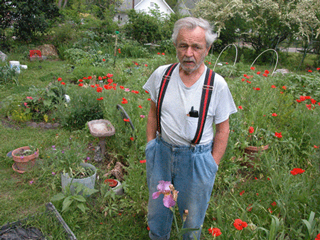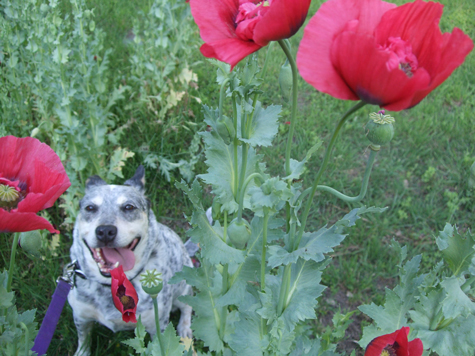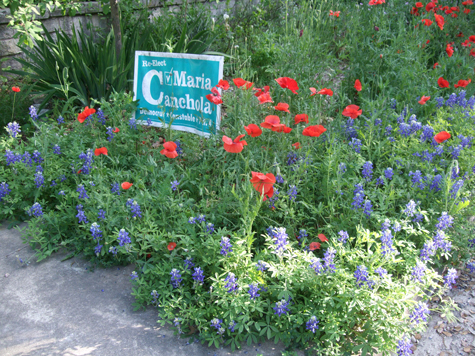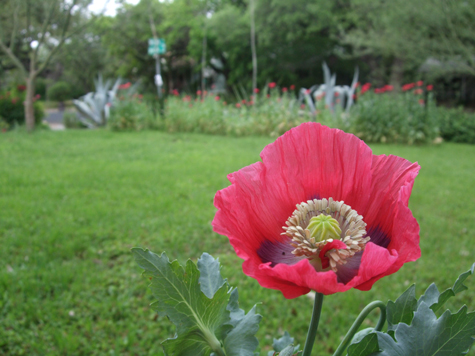Human Flower Project
Profligacy Is the Best Policy
Not one to be “designed,” poppies have a field day this March in Texas.

The March poppy crop, Austin, TX, more on the way
Photo: Human Flower Project
“I cannot get too many Renoirs,” Albert Barnes confided to friend and fellow art collector Leo Stein, 1913.
We know the feeling, except our greediness grasps in other directions – accordions, Triscuits, poppies.
It started out innocently enough, with seed from Ellen Zimmermann – the salmon colored and fluffy Shirley poppy she called ‘Dorothy Cavenaugh’ for her friend, the former president of Austin’s herb society. Those beauties performed so well in the side yard, we tried some red papaver somniferum. (We understand why the Afghan farmers go for this crop – it’s a cinch.)
 Robert Canfield of Georgetown, Texas, nourishes his poppies with coffee grounds and otherwise lets them go.
Robert Canfield of Georgetown, Texas, nourishes his poppies with coffee grounds and otherwise lets them go.
Photo: Human Flower Project
Then we wandered up to Georgetown, Texas, self-proclaimed poppy capital of the state, and fell for the orange-red Papaver rhoeas that’s most abundant up there.
Georgetown-ite Morton King was intent on discovering exactly which poppy had been the town’s original that local World War I veteran Okra Compton brought back from Flanders. The one with the black center? The variety with a little splash of white? Last we heard, even the scholarly and industrious Dr. King had not gotten to the bottom of it all. (We trust that somebody up in Georgetown has reined in the city maintenance crew that, for several years running, mowed down the unsightly plants after they bloomed, but before they’d reseeded. This scraggly phase of late spring is a small price to pay for abundance year after year.)
As the springs have passed, we’ve had more and more poppies, but fewer and fewer of the lovely ‘Dorothy Cavenaugh.’ This year there was only one. The rest were shades of red: pink, crimson, maroon, scarlet, rose, even a couple of electric orange blossoms.

Rico Shay after a walk, March 26, 2012
Photo: Human Flower Project
We asked our friend Claudia Sutton, retired from plant genetics at Cornell, to explain:
“Shirley poppies were derived from ‘sport’ corn poppies, aka Flanders Field poppies. Those are the single red parents. Gardeners would find the off flower color and collect seeds from them to plant the next year and see what happened, etc. The plants are strict annuals, so every plant dies to the ground in the fall, but freely reseeds itself. So year-to-year come all new plants.
“Second, the plants are self-infertile, so pollen from a salmon-colored double flower can’t fertilize the female parts of the same plant. An obligatory outbreeder. If a double pink plant is grown with a single red plant in proximity, the seeds derived will be a new experimental cross, and yes, at that point there may be ‘reversion’” (to bright red, it appears).
Claudia continues, on the subject of poppy color, “Mendel does not answer the question: it’s not as simple as white X red=pink. So no way to tell what the bastard offspring will look like. Seed companies that sell single color or hue varieties of poppies probably must have production fields in isolation from other poppy varieties to get them to be consistent in color and form, but I don’t know that for sure. Anyway, Shirley poppies will never breed true, since they were derived from natural variation of corn poppies.
Claudia’s advice if you’re coveting a particular shade of poppy that once bloomed in your garden but been a turn-coat: “Buy seed from a reputable flower breeder and try again.”
Now there’s an idea—since it clearly will mean more poppies.

Papaver rhoeas helps along the Canchola campaign (Ernest Pedraza, take note!)
Photo: Human Flower Project
Just within a few blocks of us are many more beautiful stands: Papaver rhoeas embellishing a sign for constable candidate Maria Canchola and some glorious somniferums along the dueling vegetable patches of Newning (though last year’s whites there haven’t returned). There are also big buds on a crop we’ve admired in years past on E. Mary. Will they be grape-purple like before or will the red-reversion impose itself here too?

Double (triple?) poppy, fit for the grand Academy house
Photo: Human Flower Project
In front of the palatial Academy house are a few very grand and fluffy crimson poppies. We may have to beg some seed in late April; despite what Claudia says, seed from this plant would have to produce monster mops, no?
 Poppy field in Argenteuil by Claude Monet, 1873
Poppy field in Argenteuil by Claude Monet, 1873
Musee d’Orsay
It actually wasn’t Renoir who seemed to have a handle on poppies (though some of his female figures sport fine hats a becoming shade of poppy orange). Rather it was Claude Monet who confessed his poppy greed. His papaver flowers can’t be contained in vases. They flutter down slopes or crowd through a whole field, spilling to the edges of the canvas.
Where we yanked out last year’s dried plants and dropped them in the grass before bagging them, a whole crop grew up this spring. Our kindly mower let a fringed wall of them stand about four feet past where the flower beds end. A drive into Lavaca County over the weekend provided a glorious show of white prickly poppy. With some of that – very thistly – we might really become the bane of the neighborhood.
“I have poppies everywhere,” a nice passer-by named Jan told us. She lives over in the Bouldin neighborhood and we’ve got to hunt her place down before the spring’s over. “My place looks like one of those crazy old lady yards,” Jan said, beaming.

At the curb, in the yard, in the flower beds…
Photo: Human Flower Project
That’s it, Jan! Just the effect we’ve been aiming for.

